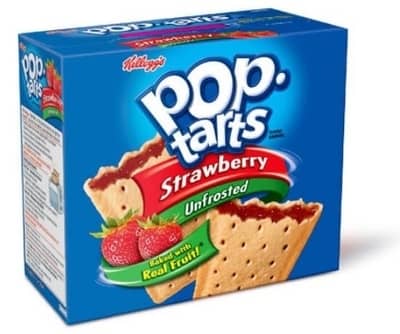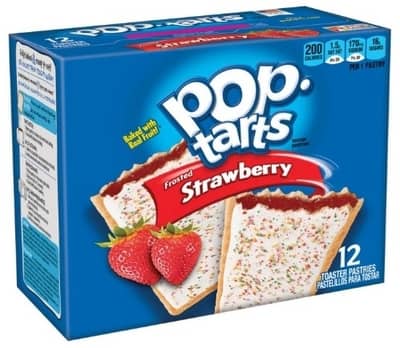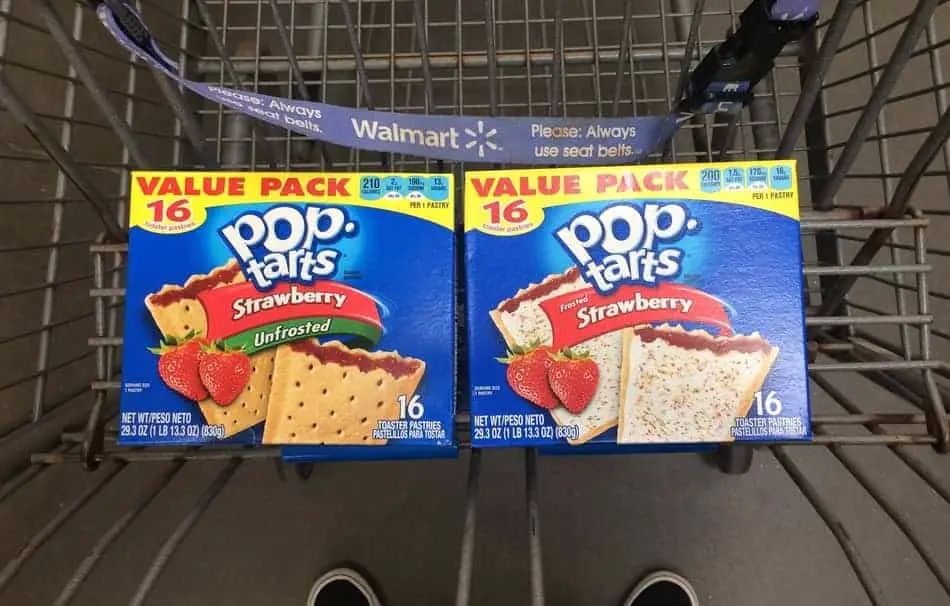Of all the Pop Tart flavors, I get asked about strawberry the most. It is probably the most popular flavor, and I know when I think of Pop Tarts, the kind with the red filling always comes to mind first. But, are they suitable for vegans? After all, both berries and grains are plant-based. If it were only that easy.
Are they vegan? The unfrosted strawberry Pop Tarts are vegan, while the frosted strawberry Pop Tarts are non-vegan. In fact, the latter variety isn’t even vegetarian-friendly. They contain gelatin which is derived from animal tissue making them unsuitable for all plant-based eaters.
What we’ll do here is look at the various reasons why the unfrosted kind is good to go while the frosted variety is off-limits.
Why Unfrosted Strawberry Pop Tarts Are Vegan

Ingredients for the unfrosted kind include:1
- Enriched Flour–Wheat Flour, Niacin, Reduced Iron, Thiamine Mononitrate (Vitamin B1), Riboflavin (Vitamin B2), and Folic Acid
- Corn Syrup and High Fructose Corn Syrup (HFCS)
- Dextrose
- Soybean and Palm Oil (with TBHQ for Freshness)
- Cracker Meal, Wheat Starch, Modified Wheat Starch
- Dried Fruit (Strawberry, Pears, Apples)
- Leavening Agents (Sodium Acid Pyrophosphate, Baking Soda, Monocalcium Phosphate)
- Citric Acid
- Caramel Color
- Soy Lecithin (An Emulsifier)
- Xanthan Gum
- Vitamin A Palmitate
- Artificial Colors (Red 40, Yellow 6)
Strawberry Pop Tarts Use Red 40
It probably comes as no surprise that Pop Tarts don’t get all of their colorings from the natural pigments present in the fruit.
When I first became vegan, I was kind of nervous to read the food label on strawberry Pop Tarts for fear they might contain what’s known as Red 4. This particular pigment, also known as carmine, is in a lot of processed food products because it can be labeled as “natural”.
Well, it’s all-natural because it derives from beetles making it a non-vegan ingredient.2,3
When I scanned the label, I was pleased to see Red 40, not Red 4. These two ingredients share a similar name and color (they’re slightly different shades), but Red 40 is petroleum-derived and can even be produced from strawberries.4,5,16
Thus, it’s always vegan.
Palm Oil Does Not Render a Food Non-Vegan
Palm oil is controversial in the vegan community, due to the effects of its cultivation on the environment.6
Eco vegans are concerned because palm oil requires large swaths of land to be cleared which contributes to rising greenhouse gas emissions.
Those who are vegan for reasons of animal welfare often raise concerns about habitat loss resulting from palm oil cultivation that has been shown to threaten critically endangered species like the orangutan and Sumatran tiger.7,8
However, the presence of palm oil does not render a food product non-vegan by most standards. If an ingredient is 100% plant-based or produced synthetically without animal-derived precursors then it’s considered vegan. Full stop.
But, if you’re a particularly prudent vegan or identify as an eco vegan, then you may want to avoid palm oil.
TBHQ Is Vegan-Friendly
TBHQ stands for tert-Butylhydroquinone.
It’s a synthetic organic compound that’s used as a preservative in food products containing vegetable oils like canola and soybean.
It’s a derivative of a reduced form of vitamin K known as hydroquinone and is vegan.
Xanthan Gum Is Generally Vegan
I bring xanthan up because vegans have raised concerns over the years about the use of egg whites in the production of this particular gum.
Another common concern is that it can be processed with whey protein, a protein that’s only found in milk.
Unlike a lot of vegan-friendly gums, xanthan isn’t a vegetable gum. Rather, it is microbially-derived.
It’s produced by fermentation with Xanthomonas campestris fed on a diet of sugars, like sucrose and glucose. However, some strains can be cultivated on lactose, which is the simple sugar present in milk.9,10
Despite all the controversy, the involvement of egg white and lactose in the production of xanthan gum is thought to be pretty rare and the Vegetarian Resource Group (VRG) considers the additive to be generally suitable for vegans.11
Caramel Color Is Vegan-Friendly
Like Red 40, caramel color is another common colorant that can raise red flags in the vegan community. When most folks think of caramel color, they think of actual caramel (the confection).
Both are made via the Maillard browning reaction performed on substances containing simple sugars.
However, while caramel candy is produced with milk (by browning lactose), caramel color is made by browning other simple sugars like fructose and glucose—typically, in malt syrup, or molasses.12
Plant-Based Lecithin Is Used
Lecithin is a molecule that attracts both water and fat, so it makes for a great emulsifier. The ingredient is rather abundant in egg yolks, but luckily it can be found several plant-based sources like soybean and sunflower oils.
Which is the case for strawberry Pop Tarts, which contain soy lecithin.
What About Vitamin A Palmitate?
Vitamin A palmitate contains palmitic acid which is one of those ingredients that can be animal-derived if sourced from x, but vegan-friendly if sourced from y.13
Vitamin A palmitate is considered by the VRG to be potentially non-vegan.6
Most vegans don’t scrutinize such ingredients too heavily, because there’s really no way to know.
But, if you’re an especially prudent plant-based eater, you may want to avoid the ingredient.
Why Frosted Strawberry Pop Tarts Are Non-Vegan

Ingredients for the frosted kind include:14
- Enriched Flour (Wheat Flour, Niacin, Reduced Iron, Thiamin Mononitrate, Riboflavin, Folic Acid)
- Corn Syrup, High Fructose Corn Syrup
- Dextrose, Cornstarch, Sugar, Salt
- Soybean and Palm Oil (with TBHQ for Freshness)
- Bleached Wheat Flour, Wheat Starch, Modified Wheat Starch, Yellow Corn Flour
- Dried Strawberries, Pears, and Apples
- Leaveners (Baking Soda, Sodium Acid Pyrophosphate, Monocalcium Phosphate)
- Citric Acid
- Gelatin
- Food Colorants (Caramel Color, Turmeric Extract Color, Red 40, Blue 1)
- Xanthan Gum, Soy Lecithin
- Vitamin A Palmitate
It came as a surprise to me when I found out that gelatin tends to be used in frosting added to breakfast foods.
I first ran across gelatin in frosting when I took the time to scan the ingredients on a box of Frosted Mini-Wheats.
Specifically, ingredients in Frosted Mini-Wheats include:15
- Whole Grain Wheat
- Sugar
- Brown Rice Syrup
- Gelatin
- BHT for Freshness
- Vitamins and Minerals (Reduced Iron, Folic Acid)
Don’t get me wrong, not all frosting contains gelatin, but the kind you’ll encounter on highly processed breakfast foods often does—i.e. the hardened kind that looks like snow-capped mountains.
So you know, gelatin is derived from animals—usually pork—by boiling down bones, cartilage, and skin, etc. If it sounds disgusting, that’s because it is.
The additive is used to improve texture. There are several 100% plant-based gelatin replacements in the food industry, but the ingredient continues to be used, and I doubt it’s going anywhere anytime soon.
That’s it for the vegan status of strawberry Pop Tarts. Thanks for reading.
You may also want to check out the following related articles:
References
- Pop-Tarts Unfrosted Strawberry, 16 Toaster Pastries. https://www.walmart.com/ip/Pop-Tarts-Unfrosted-Strawberry-16-Toaster-Pastries/10891846
- Bug-Based Food Dye Should Be Exterminated, Says CSPI. https://cspinet.org/news/bug-based-food-dye-should-be-exterminated-says-cspi-20060501
- Carminic Acid https://en.wikipedia.org/wiki/Carminic_acid
- Potera, C., 2010. Diet and nutrition: the artificial food dye blues. Environ Health Perspect. 118 (10), A428–A431.
- Stern, P.W. 1988. Food, drug and cosmetic colors, in Pigment Handbook, Vol. 1. P.A. Lewis, Ed. John Wiley & Sons, New York, pp. 925–945.
- Vegetarian Journal’s Guide To Food Ingredients. https://www.vrg.org/ingredients/
- Shears, Richard (30 March 2012). “Hundreds of orangutans killed in north Indonesian forest fires deliberately started by palm oil firms”. Daily Mail. London. https://www.dailymail.co.uk/news/article-2122544/Hundreds-orangutans-killed-north-Indonesian-forest-fires-deliberately-started-palm-oil-firms.html?ITO=1490
- “Camera catches bulldozer destroying Sumatra tiger forest”. World Wildlife Fund. 12 October 2010. http://wwf.panda.org/?195632/Camera-catches-bulldozer-destroying-Sumatra-tiger-forest
- EFSA Panel on Food Additives and Nutrient Sources (14 July 2017). “Re‐evaluation of xanthan gum (E 415) as a food additive”. EFSA Journal. European Food Safety Authority. 15 (2): e04909.
- Tortora, G.J., Funke, B.R., & Case, C.L. (2010). Microbiology: An Introduction, 10th edition. San Francisco: Benjamin Cummings. Pg. 801.
- Xanthan Gum Is Vegan – No Egg Whites. https://www.vrg.org/blog/2018/06/28/xanthan-gum-is-vegan-no-egg-whites/
- Caramel Color, Production. https://en.wikipedia.org/wiki/Caramel_color#Production
- Animal-derived Ingredients Resource | Living https://www.peta.org/living/food/animal-ingredients-list/
- Pop-Tarts Frosted Variety Pack, 48 Toaster Pastries (24 Frosted Strawberry, 24 Frosted Brown Sugar Cinnamon). https://www.walmart.com/ip/Kellogg-s-Pop-Tarts-Frosted-Brown-Sugar-Cinnamon-Frosted-Strawberry-Variety-Pack-86-Oz-48-Ct/25875647
- Frosted Mini Wheats, Original. https://www.nutritionix.com/i/kelloggs/frosted-mini-wheats-original/51d300c1cc9bff111580fff5
- Natural Colorants For Food and Nutraceutical Uses (Page). Francisco Delgado-Vargas, Octavio Paredes-López – CRC – 2003. ISBN 1-58716-076-5

